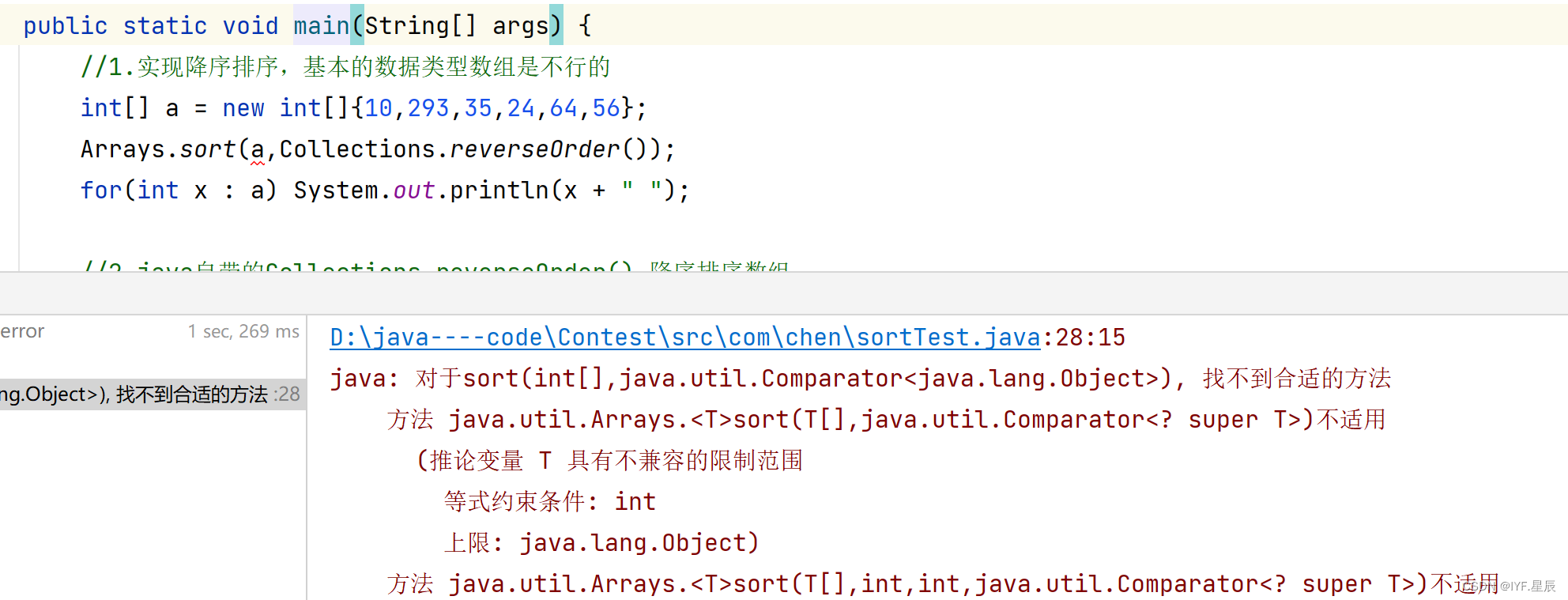Java Sort 方法的使用(包含Arrays.sort(),Collections.sort()以及Comparable,Comparator的使用 )
目录
Comparable && Comparator的使用:
Comparable:
Comparator:
Arrays.sort()的使用:
升序排序:
降序排序:
自定义排序方法:
在日常的刷题或开发中,很多时候我们需要对数据进行排序,以达到我们的预期效果的作用。那么这些排序方法具体怎么实现和使用呢?本文就来好好缕一缕,总结一下这些方法:
Comparable && Comparator的使用:
Comparable:
当我们对类中的对象进行比较时,要保证对象时可比较的,这时我们就需要用到Comparable 或 Comparator接口,然后重写里面的compareTo()方法。假设我们有一个学生类,默认需要按照学生的年龄age排序,具体实现如下:
class Student implements Comparable{ private int id; private int age; private String name; public Student(int id, int age, String name) { this.id = id; this.age = age; this.name = name; } @Override public int compareTo(Student o) { //降序 //return o.age - this.age; //升序 return this.age - o.age; } public int getId() { return id; } public void setId(int id) { this.id = id; } public int getAge() { return age; } public void setAge(int age) { this.age = age; } public String getName() { return name; } public void setName(String name) { this.name = name; } @Override public String toString() { return "Student{" + "id=" + id + ", age=" + age + ", name='" + name + '\'' + '}'; } } 这里说一下 public int compareTo(Student o) 方法,它返回三种 int 类型的值: 负整数,零 ,正整数:
| 返回值 | 含义 |
| 正整数 | 当前对象的值 > 比较对象的值,升序排序 |
| 零 | 当前对象的值 = 比较对象的值,不变 |
| 负整数 | 当前对象的值 < 比较对象的值,降序排序 |
测试:
public class SortTest { public static void main(String[] args) { List list = new ArrayList<>(); list.add(new Student(103,25,"关羽")); list.add(new Student(104,21,"张飞")); list.add(new Student(108,18,"刘备")); list.add(new Student(101,32,"袁绍")); list.add(new Student(109,36,"赵云")); list.add(new Student(103,16,"曹操")); System.out.println("排序前:"); for(Student student : list){ System.out.println(student.toString()); } System.out.println("默认排序后:"); Collections.sort(list); for(Student student : list){ System.out.println(student.toString()); } } } 运行结果:
排序前: Student{id=103, age=25, name='关羽'} Student{id=104, age=21, name='张飞'} Student{id=108, age=18, name='刘备'} Student{id=101, age=32, name='袁绍'} Student{id=109, age=36, name='赵云'} Student{id=103, age=16, name='曹操'} 默认排序后: Student{id=103, age=16, name='曹操'} Student{id=108, age=18, name='刘备'} Student{id=104, age=21, name='张飞'} Student{id=103, age=25, name='关羽'} Student{id=101, age=32, name='袁绍'} Student{id=109, age=36, name='赵云'} Comparator:
Comparator的两种使用方法:
Collections.sort(list,Comparator); list.sort(Comparator);
这个时候需求又来了,默认是用 age 排序,但是有的时候需要用 id 来排序怎么办? 这个时候比较器 :Comparator 就排上用场了:
//自定义排序:使用匿名内部类,实现Comparator接口,重写compare方法 Collections.sort(list, new Comparator() { @Override public int compare(Student o1, Student o2) { return o1.getId() - o2.getId(); } }); //自定义排序2 list.sort(new Comparator() { @Override public int compare(Student o1, Student o2) { return o1.getId() - o2.getId(); } }); compare(Student o1, Student o2) 方法的返回值跟 Comparable<> 接口的 compareTo(Student o) 方法返回值意思相同
运行结果:
自定义ID排序后: Student{id=101, age=32, name='袁绍'} Student{id=103, age=16, name='曹操'} Student{id=103, age=25, name='关羽'} Student{id=104, age=21, name='张飞'} Student{id=108, age=18, name='刘备'} Student{id=109, age=36, name='赵云'}源码:
import java.util.ArrayList; import java.util.Collections; import java.util.Comparator; import java.util.List; class Student implements Comparable{ private int id; private int age; private String name; public Student(int id, int age, String name) { this.id = id; this.age = age; this.name = name; } @Override public int compareTo(Student o) { //降序 //return o.age - this.age; //升序 return this.age - o.age; } public int getId() { return id; } public void setId(int id) { this.id = id; } public int getAge() { return age; } public void setAge(int age) { this.age = age; } public String getName() { return name; } public void setName(String name) { this.name = name; } @Override public String toString() { return "Student{" + "id=" + id + ", age=" + age + ", name='" + name + '\'' + '}'; } } public class SortTest { public static void main(String[] args) { List list = new ArrayList<>(); list.add(new Student(103,25,"关羽")); list.add(new Student(104,21,"张飞")); list.add(new Student(108,18,"刘备")); list.add(new Student(101,32,"袁绍")); list.add(new Student(109,36,"赵云")); list.add(new Student(103,16,"曹操")); System.out.println("排序前:"); for(Student student : list){ System.out.println(student.toString()); } System.out.println("默认排序后:"); Collections.sort(list); for(Student student : list){ System.out.println(student.toString()); } //自定义排序:使用匿名内部类,实现Comparator接口,重写compare方法 Collections.sort(list, new Comparator() { @Override public int compare(Student o1, Student o2) { return o1.getId() - o2.getId(); } }); System.out.println("自定义ID排序后:"); for(Student student : list){ System.out.println(student.toString()); } //自定义排序2 list.sort(new Comparator() { @Override public int compare(Student o1, Student o2) { return o1.getId() - o2.getId(); } }); } } Arrays.sort()的使用:
升序排序:
1.正常排序一个数组:Arrays.sort(int [] a);
我们看一下源码:
public static void sort(int[] a) { DualPivotQuicksort.sort(a, 0, a.length - 1, null, 0, 0); }本质上还是用到了快排,同时默认时从小到大进行排序的,具体实现:
public static void main(String[] args) { //1.Arrays.sort(int[] a) 默认从小到达排序 int[] a = new int[]{10,2,7,8,9,15,7}; System.out.println("默认时从小到大排序:"); Arrays.sort(a); for(int x : a) System.out.print(x + " "); }运行结果:
默认时从小到大排序: 2 7 7 8 9 10 15 2.在一定区间内排序数组:Arrays.sort(int[] a, int fromIndex, int toIndex)
->规则为从fromIndex<= a数组 实现方法:Collections.reverseOrder() 要实现降序排序,得通过包装类型的数组来实现,基本数据类型数组是不行的: 正确用法: 运行结果: 运行结果: 同时,我们可以用lambda表达是简化书写: 运行结果: 源码: 补充,二维数组的排序:通过实现Comparator接口来自定义排序二维数组,以下面为例: 运行结果: 好啦~本文到这里也是接近尾声了,希望有帮助到你,整理不易,希望多多三联支持呀~ 结语: 写博客不仅仅是为了分享学习经历,同时这也有利于我巩固知识点,总结该知识点,由于作者水平有限,对文章有任何问题的还请指出,接受大家的批评,让我改进。同时也希望读者们不吝啬你们的点赞+收藏+关注,你们的鼓励是我创作的最大动力! public static void main(String[] args) { //2.Arrays.sort(int[] a, int fromIndex, int toIndex) //规则为从fromIndex<= a数组 降序排序:
public static 
//2.java自带的Collections.reverseOrder() 降序排序数组 System.out.println("java自带的Collections.reverseOrder():"); Integer[] integers = new Integer[]{10, 293, 35, 24, 64, 56}; Arrays.sort(integers, Collections.reverseOrder()); for (Integer integer : integers) System.out.print(integer + " ");java自带的Collections.reverseOrder(): 293 64 56 35 24 10 自定义排序方法:
自定义排序方法,需要实现java.util.Comparetor 接口中的compare方法
//3.自定义排序方法,实现java.util.Comparetor 接口中的compare方法 Integer[] integers2 = new Integer[]{10, 293, 35, 24, 64, 56}; Arrays.sort(integers2, new Comparator自定义排序方法: 293 64 56 35 24 10 //4.lambda表达式简化书写 Integer[] integers3 = new Integer[]{10, 293, 35, 24, 64, 56}; Arrays.sort(integers3, (o1, o2) -> { return o2 - o1; }); System.out.println("lambda表达式简化书写:"); for (int x : integers3) System.out.print(x + " ");lambda表达式简化书写: 293 64 56 35 24 10 import java.util.*; public class sortTest { public static void main1(String[] args) { //1.Arrays.sort(int[] a) 默认从小到达排序 int[] a = new int[]{10,2,7,8,9,15,7}; System.out.println("默认时从小到大排序:"); Arrays.sort(a); for(int x : a) System.out.print(x + " "); } public static void main2(String[] args) { //2.Arrays.sort(int[] a, int fromIndex, int toIndex) //规则为从fromIndex<= a数组 import java.util.Arrays; import java.util.Comparator; class Cmp implements Comparator

下一篇:前端Vue日常工作中--元素居中
